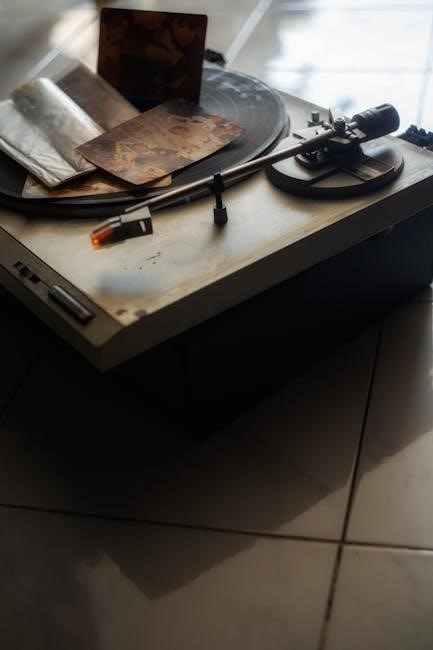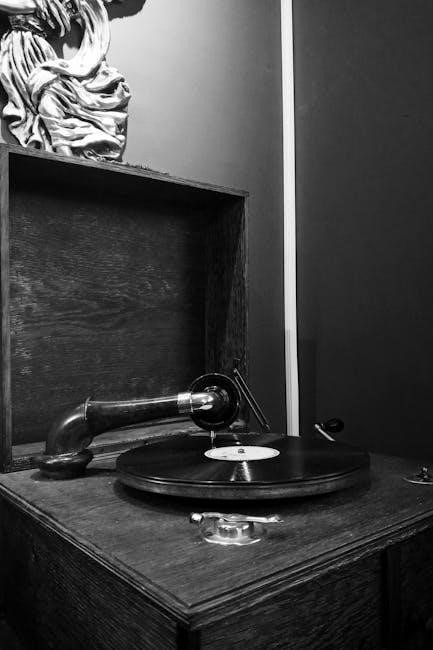GE Range LP Conversion Kits enable safe and efficient conversion of natural gas ranges to propane. These kits include essential components and instructions for a seamless transition, ensuring compatibility and optimal performance. Designed for specific GE models, they provide a reliable solution for users needing to switch fuel types. Always follow manufacturer guidelines to guarantee safety and proper functionality.
1.1 Overview of LP Conversion Kits
LP conversion kits are specifically designed to adapt GE natural gas ranges for propane use. These kits include essential components like orifices, regulators, and instructions for a safe and proper conversion. They ensure optimal performance and compliance with safety standards when switching from natural gas to propane. Each kit is tailored to specific GE range models, guaranteeing compatibility and ease of installation. Proper use of these kits is crucial for maintaining appliance efficiency and safety, and they often require professional installation to meet manufacturer guidelines and local regulations.
1;2 Importance of Proper Conversion
Proper conversion is vital for safety, efficiency, and appliance longevity. Incorrect installation can lead to gas leaks, fire hazards, or reduced performance. Adhering to manufacturer guidelines ensures optimal functionality and compliance with safety standards. Proper conversion also maintains warranty validity and prevents potential damage to the range. It’s crucial to follow precise instructions and use genuine LP conversion kits to avoid risks and ensure reliable operation of your GE range. Always consider consulting a professional if unsure about any step of the process to guarantee a safe and effective conversion.

Safety Precautions and Warnings
Always disconnect power and gas supply before starting. Ensure proper ventilation and follow manufacturer instructions to avoid hazards. Use correct tools and materials to prevent gas leaks or fires.
2.1 General Safety Guidelines
Ensure the range is disconnected from electrical power and gas supply before conversion. Always follow the manufacturer’s instructions and safety protocols provided with the LP conversion kit. Proper ventilation is crucial to prevent gas accumulation. Use only the tools and materials specified in the kit to avoid potential hazards. Never attempt the conversion without proper knowledge or assistance. Keep the area clear of flammable materials and ensure all safety precautions are strictly followed to prevent accidents. Adhere to local regulations and safety standards throughout the process.
2.2 Proper Ventilation Requirements
Proper ventilation is critical during and after the LP conversion to prevent gas accumulation. Ensure the area is well-ventilated to avoid propane fumes, which are heavier than air and can settle in low spaces. Open windows and use fans to maintain airflow. Never work in an enclosed space without adequate ventilation. Keep the work area free of flammable materials and ensure all vents are clear. Proper ventilation ensures safety and prevents potential hazards during the conversion process. Always prioritize airflow to maintain a safe environment.
2.3 Electrical and Gas Safety Tips
When working with GE Range LP Conversion Kits, ensure all electrical power is disconnected before starting. Shut off the gas supply and verify all connections are secure to prevent leaks. Use appropriate tools to avoid damaging components. Follow manufacturer guidelines for torque specifications on gas fittings. Never test electrical circuits with the power on. Ensure proper grounding to prevent electrical hazards. After conversion, leak-test all gas lines using a soap solution. Keep a fire extinguisher nearby and avoid smoking or open flames during the process. Always verify gas and electrical systems are safe before restoring power or relighting pilots.

Tools and Materials Required
Essential tools include adjustable wrenches, nut drivers, and open-end wrenches. The LP conversion kit provides necessary components like orifices and stickers for accurate adjustments and safety notifications.
3.1 Tools Needed for Conversion
The tools required for converting your GE range include an adjustable wrench for gas line connections, a 7mm or 9/32 nut driver for burner removal, and an open-end wrench for regulator adjustments. Additional tools like screwdrivers and pliers may be necessary for specific model variations. Ensure all tools are readily available to streamline the conversion process and avoid delays. Proper tools are essential for safely and accurately completing the propane conversion, as outlined in the LP kit instructions.
3.2 Materials Included in the LP Kit
The LP conversion kit includes propane-specific orifices for burners and the oven, ensuring proper gas flow and combustion. A conversion label is provided to indicate the appliance’s propane setup. Additional components may vary by model but typically include necessary adapters and fittings. These materials are designed to meet safety standards and ensure efficient operation with propane. Always verify kit contents against the installation manual to confirm all parts are present before starting the conversion process.

Understanding the LP Conversion Kit
The LP conversion kit is designed to adapt GE gas ranges for propane use, ensuring safe and efficient operation. It includes specialized components like orifices and labels.
4.1 Components of the Conversion Kit
The GE LP conversion kit includes essential components such as propane orifices, an adjustment tool, and a conversion label. These parts ensure a safe and proper transition from natural gas to propane. The orifices are specifically sized for propane’s higher pressure, while the label alerts future users of the appliance’s fuel type. Additionally, the kit may contain detailed instructions and diagrams to guide the installation process accurately. Each component plays a crucial role in maintaining appliance performance and safety standards.
4.2 Purpose of Each Component
The propane orifices regulate gas flow for proper combustion, ensuring efficient burning with propane. The adjustment tool fine-tunes burner settings for optimal performance. The conversion label serves as a permanent record, alerting future users that the appliance operates on propane. Instructions and diagrams guide installation, while safety stickers emphasize the fuel type. Each component ensures safety, efficiency, and compliance with manufacturer standards. Proper use of these parts guarantees reliable operation and prevents potential hazards. Their combined purpose is to facilitate a smooth, error-free conversion process.
Pre-Installation Steps
Ensure safety by disconnecting electrical power and shutting off the gas supply. Remove burner caps, grates, and burner heads for easy access during conversion. Follow these steps carefully.
5.1 Disconnecting Electrical Power
Before starting the conversion, ensure all electrical power to the range is disconnected. Locate the main circuit breaker or fuse box controlling the range’s power supply. Switch off the breaker or remove the appropriate fuse to completely power down the appliance. Verify that the range is powered off using a voltage tester to avoid any accidental start-ups. This critical step ensures your safety while performing the conversion. Always prioritize caution when working with electrical systems, and consult a professional if unsure.
5.2 Shutting Off Gas Supply
Shutting off the gas supply is crucial for safety during conversion. Locate the manual shut-off valve connected to the gas line behind or near the range. Turn the valve clockwise until it stops to close it. Once closed, ensure the valve is tightly secured. Verify the gas supply is off by attempting to light the burners or checking for any gas leaks with a soapy water solution or a gas detector. If you smell gas, do not proceed and contact a professional immediately. Always follow safety guidelines to prevent accidents during the conversion process.
5.3 Removing Burner Caps and Grates
Remove the burner caps and grates to access the burner orifices. Use a screwdriver or the tool provided in the LP kit to gently lift and set aside the caps and grates. Place them in a safe location to avoid damage or misplacement. This step ensures easy access to the burner components for orifice replacement. Be careful not to scratch the cooktop surface during removal. Once removed, you can proceed with the conversion process, starting with the burner orifice replacement as outlined in the instructions.

Converting the Pressure Regulator
6.1 Accessing the Pressure Regulator
Pull the range away from the wall to access the pressure regulator, typically located near the gas supply line at the back of the range. Refer to the wiring diagram or mini-manual for precise location guidance.
To access the pressure regulator, carefully pull the GE range away from the wall. The regulator is typically located near the gas supply line at the back of the range. Ensure the area is clear and well-ventilated. Refer to the wiring diagram or mini-manual included with the LP kit for precise location guidance. This step is crucial for safely converting the regulator to propane settings.
6.2 Adjusting the Regulator for Propane
Once the pressure regulator is accessed, use an adjustable wrench to turn the adjustment screw counterclockwise to set the regulator for propane. Refer to the kit’s instructions for the correct pressure setting. After adjusting, install the LP orifice provided in the conversion kit. Tighten securely to ensure a proper seal. Apply the propane conversion sticker near the regulator as a warning to future users. This step ensures the appliance operates safely and efficiently with propane gas.

Instructions for Converting Burners
7.1 Removing and Replacing Burner Orifices
Remove burner caps and grates. Use a wrench to take out natural gas orifices. Replace them with LP orifices from the kit. Secure tightly for proper seal.
Start by disconnecting electrical power and shutting off the gas supply. Remove burner caps, grates, and burner heads for access. Use a wrench to remove the natural gas orifices. Replace them with the LP orifices provided in the conversion kit. Ensure they are securely installed to maintain a proper seal. Refer to the kit’s instructions for specific torque requirements. Double-check all connections to prevent gas leaks. Once complete, reinstall the burner heads, grates, and caps in the correct order.
7.2 Adjusting Air Shutter Settings
After replacing the burner orifices, adjust the air shutter settings to ensure proper propane combustion. Locate the air shutter, typically near the burner base. Open or close the shutter to achieve a clean-burning, blue flame. If the flame appears yellow or produces soot, adjust the shutter slightly. Refer to the kit’s instructions for specific settings. Proper adjustment ensures efficient fuel use and prevents carbon buildup. Double-check the flame appearance and stability before proceeding with the conversion process.

Converting the Oven for Propane Use
Replace the oven orifice with the one provided in the LP kit. Ensure proper installation and alignment to maintain optimal propane flow and oven performance. Refer to the kit’s instructions for specific guidance on adjusting settings and verifying functionality.
8.1 Replacing the Oven Orifice
To replace the oven orifice, first, ensure the gas supply is shut off and the range is disconnected from electrical power. Locate the oven orifice, typically found near the gas valve. Remove the existing orifice using an adjustable wrench. Install the LP orifice provided in the conversion kit, ensuring it is securely tightened. Refer to the kit’s instructions for specific torque specifications. Once installed, verify that the orifice is properly seated and aligned. This step is crucial for maintaining proper propane flow and ensuring safe oven operation. Always follow the manufacturer’s guidelines for installation.
8.2 Ensuring Proper Oven Functionality
After replacing the oven orifice, ensure the oven functions correctly by testing the burner flame. Turn on the oven and observe the flame color; it should be blue for proper combustion. If the flame appears yellow or uneven, adjust the air shutter according to the kit instructions. Verify that the oven heats evenly and reaches the correct temperatures. Apply the conversion sticker near the regulator to indicate the appliance is set for propane use. Refer to the manual for specific testing procedures to confirm optimal functionality.

Reassembly and Testing
After reassembling the burners and grates, test the appliance by lighting burners and checking for proper ignition and flame color. Ensure all components function correctly.
9.1 Reassembling Burners and Grates
After converting the burners, carefully reassemble them by aligning the burner heads with their respective bases. Secure them using the screws provided in the LP kit. Once the burners are in place, reinstall the grates, ensuring they fit snugly and evenly. Double-check that all components are properly aligned and stable to avoid any imbalance or risk of tipping.
Before testing, inspect the burners and grates for any signs of damage or misalignment. Ensure all connections are secure and leak-free. This step is critical for safe and efficient operation of your propane-powered range.
9.2 Testing the Burners and Oven
After reassembly, test each burner by igniting them one by one. Ensure a steady, blue flame without yellow tips, indicating proper propane combustion. Check the oven by setting it to a specific temperature and verifying it heats evenly. Use a thermometer to confirm accuracy. Inspect for any leaks around connections using a soapy water solution. If bubbles form, tighten the connections and retest.
Once satisfied with the burner and oven performance, apply the propane conversion sticker near the regulator. This alerts future users of the appliance’s propane configuration. Verify all safety guidelines are met before regular use.

Model-Specific Instructions
Model-specific instructions for GE ranges like JGBS30DEKBB, JGBS60REKSS, and JGBS10DEMWW ensure accurate LP conversion. Each model requires unique steps and adjustments for proper functionality. Always use the correct LP kit for your range to guarantee safe and efficient conversion. Follow detailed instructions provided for your specific model to achieve optimal results. Refer to the official GE manual for precise guidance tailored to your appliance.
10.1 GE JGBS30DEKBB Model Conversion
For the GE JGBS30DEKBB model, the LP conversion process involves specific steps to ensure compatibility with propane. Start by disconnecting electrical power and shutting off the gas supply. Remove the burner caps and grates for access. Install the LP orifice provided in the conversion kit, ensuring proper alignment and seating. Adjust the burner air shutter settings as per the instructions to optimize propane flow. Verify that all connections are secure and test the burners to ensure proper ignition and flame consistency. Always refer to the official GE manual for detailed guidance tailored to this model.
10.2 GE JGBS60REKSS Model Conversion
Converting the GE JGBS60REKSS to propane requires careful adherence to specific instructions. Begin by disconnecting electrical power and shutting off the gas supply. Remove the burner caps and grates to access the components. Replace the natural gas orifice with the LP orifice provided in the conversion kit, ensuring it is securely installed. Adjust the pressure regulator to the correct propane setting, following the manufacturer’s guidelines. Modify the burner air shutter settings as needed to achieve the proper flame. After completing the conversion, test all burners and the oven to ensure they function correctly with propane.
10.3 GE JGBS10DEMWW Model Conversion
For the GE JGBS10DEMWW model, the LP conversion process involves specific steps to ensure compatibility with propane. Start by disconnecting the electrical power and shutting off the gas supply. Remove the burner caps and grates to access the orifices. Replace the natural gas orifice with the LP orifice provided in the conversion kit, ensuring a secure fit. Adjust the pressure regulator to the correct propane setting as outlined in the instructions. Verify the burner and oven functionality by testing each component after the conversion. Always follow the manufacturer’s guidelines for this model to ensure safety and proper operation.
Troubleshooting Common Issues
Common issues during LP conversion include improper burner function or gas flow problems. Check for correct orifice installation and regulator settings. Verify all connections are secure and consult the manual for guidance if issues persist.
11.1 Common Conversion Mistakes
One of the most frequent errors during LP conversion is incorrect orifice installation. Ensure the propane-specific orifices are securely fitted to prevent gas leaks. Another mistake is neglecting to adjust the regulator settings, which can lead to inefficient burner performance. Additionally, failing to shut off the gas supply before starting the conversion can result in safety hazards. Always refer to the manual for precise instructions and double-check all modifications to avoid these common pitfalls.
11.2 Resolving Gas Flow Problems
If gas flow issues arise after conversion, check the regulator settings and ensure they are adjusted correctly for propane. Inspect the orifices for blockages or improper installation, as this can disrupt gas flow. Verify that the gas supply line is fully open and free from kinks. If issues persist, consult the manual or contact a professional to diagnose and resolve the problem. Properly addressing gas flow problems is crucial for safety and optimal appliance performance.

Post-Conversion Maintenance
After converting to propane, regularly clean burners and orifices to ensure proper gas flow. Check for blockages and wear, and replace parts as needed. Follow the manual for maintenance schedules to keep your range functioning efficiently and safely.
12.1 Cleaning After Conversion
After converting your GE range to propane, regular cleaning is essential to maintain performance and safety. Use a soft brush to remove debris from burners and orifices. Wipe grates and caps with a mild detergent and rinse thoroughly. Ensure all components are dry before reinstalling. Check for blockages in gas ports and clean as needed. Avoid harsh chemicals that could damage finishes. Refer to the manual for specific cleaning instructions tailored to your model. Keeping your range clean ensures efficient gas flow and prevents potential issues.
12.2 Regular Maintenance Tips
Regular maintenance ensures your GE range operates efficiently after propane conversion. Inspect burner orifices and ports for blockages and clean them periodically. Check gas hoses for signs of wear or leaks and replace if necessary. Ensure proper ventilation in your kitchen to prevent gas buildup. Schedule annual professional inspections to verify gas pressure and burner performance. Always refer to your GE range’s manual for model-specific maintenance recommendations. Consistent upkeep helps maintain safety, efficiency, and longevity of your propane-powered appliance.
Best Practices for LP Conversion
Always follow manufacturer guidelines for GE range LP conversion to ensure safety and efficiency. Consulting a professional is recommended for complex steps. Regular maintenance and adherence to safety protocols are crucial for optimal performance.
13.1 Following Manufacturer Guidelines
Adhering to GE’s instructions ensures a safe and efficient LP conversion. Always disconnect power and gas supply before starting. Follow the wiring diagram and mini-manual provided with the kit. Replace orifices and adjust burners as specified. Apply the propane conversion sticker near the regulator to alert future users. Refer to the manual for cleaning and maintenance tips. Consulting a professional is recommended for complex steps. This ensures compliance with safety standards and optimal appliance performance. Proper conversion guarantees reliability and longevity of your GE range.
13.2 Consulting Professional Help
For a safe and correct LP conversion, consider hiring a qualified technician, especially if you’re unsure about the process. Professionals ensure compliance with safety standards and manufacturer instructions. They handle complex steps like regulator adjustment and orifice replacement efficiently. Improper installation can lead to hazards, making expert assistance crucial. While DIY is possible, professional help guarantees reliability and adherence to local codes. This ensures your GE range operates safely and efficiently with propane, avoiding potential risks associated with incorrect conversions.
Completing the LP conversion safely and correctly ensures reliable performance. Always refer to manufacturer guidelines and verify all adjustments. Enjoy your propane-powered GE range with confidence.
14.1 Final Checks and Verification
After completing the LP conversion, inspect all connections and components for tightness and proper installation. Test each burner and the oven to ensure they function correctly with propane. Verify there are no gas leaks using a soap solution or leak detector. Check that the pressure regulator is adjusted accurately and the conversion sticker is applied near the regulator. Review the installation against the manufacturer’s guidelines to confirm everything is up to standard. This final verification ensures safety and optimal performance of your propane-powered GE range.
14.2 Enjoying Your Propane-Powered Range
With the conversion complete, you can now enjoy the benefits of propane-powered cooking. Propane offers consistent heat, energy efficiency, and reliable performance. Take advantage of precise temperature control for optimal cooking results. Remember to maintain regular cleaning and inspections to ensure longevity. Always follow safety guidelines and manufacturer recommendations for continued safe operation. Your GE range is now ready to provide years of reliable service with propane, enhancing your culinary experience while adhering to safety and efficiency standards.
